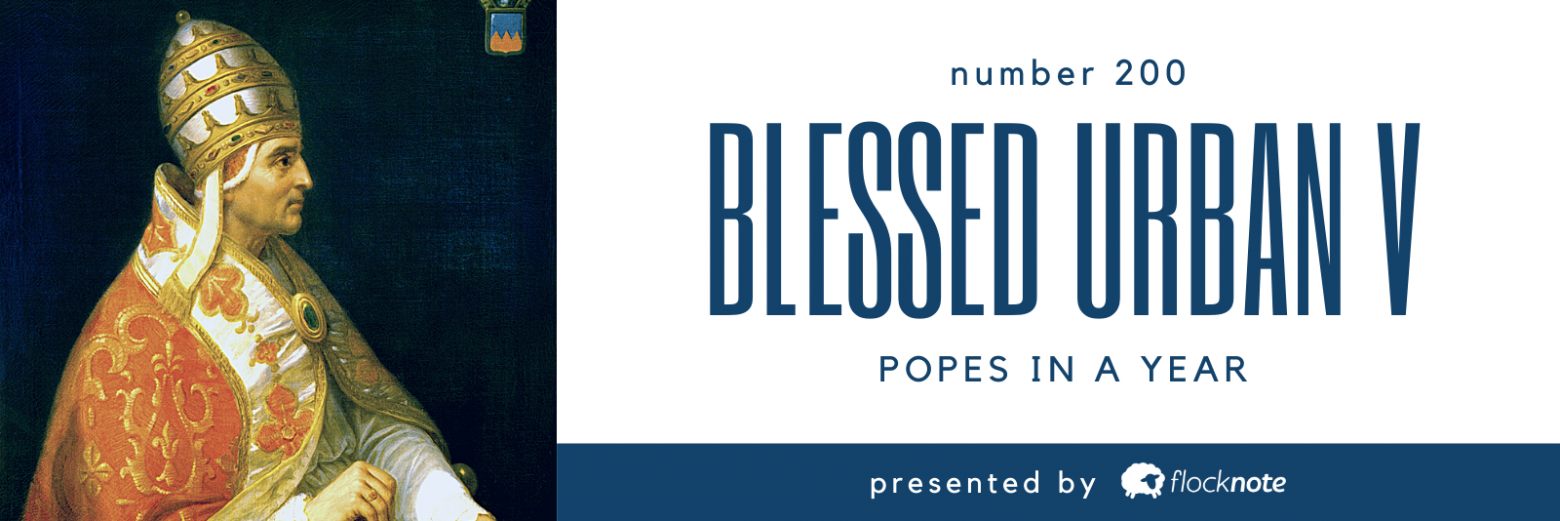
Pope from September 28, 1362 - December 19, 1370
Lived: 1310 - December 19, 1370
Birth name: Guillaume de Grimoard
Who was this guy before he was pope?
Guillame de Grimoard was born in 1310 to a noble French family, the second of four children. He entered the Benedictine Order at the age of 17 and became so devoted to his monastic life that he wore the Benedictine habit even as pope. Guillaume became a priest in 1334, then went on to study both literature and canon law, earning his doctorate in the latter in 1342. Over the next two decades, he was sent on three different missions to Italy by his papal predecessors, while also serving (respectively) as vicar general in Clermont and Uzes, prior at Notre Dame du Pre, and abbot of two different monasteries.
Okay, give me the scoop on Urban V.
Blessed Urban V wasn’t a cardinal at his election, but was nevertheless chosen by a bickering College of Cardinals who couldn’t decide amongst themselves. He chose the name Urban because, as he said, “all the popes who had borne the name had been saints.”
Giving the Church a winner at No. 200, Urban preferred using peace rather than the sword and was especially opposed to the nepotism and corruption that tempted so many church leaders of the day. Urban was a great patron of education, consenting most notably to the establishment of the University of Krakow, now the Jagiellonian University, which would eventually educate the likes of St. John Cantius, Nicolaus Copernicus, and St. John Paul II.
Urban died in Avignon on December 19, 1370. He was initially buried there as well, but his relics were moved (according to his wishes) two years later to the Abbey Church of St. Victor in Marseilles, where he'd once served as abbot. When pilgrims began to venerate the holy site, miracles were numerous, and calls for his canonization quickly reached Pope Gregory XI. As it turned out, however, he wouldn’t be beatified until 500 years after his death, when Blessed Pope Pius IX did so in 1870.
Urban died in Avignon on December 19, 1370. He was initially buried there as well, but his relics were moved (according to his wishes) two years later to the Abbey Church of St. Victor in Marseilles, where he'd once served as abbot. When pilgrims began to venerate the holy site, miracles were numerous, and calls for his canonization quickly reached Pope Gregory XI. As it turned out, however, he wouldn’t be beatified until 500 years after his death, when Blessed Pope Pius IX did so in 1870.
What was he known for?
Urban V is best known for actually returning the papacy to Rome, if only for a short time. Not wanting to waste the work of Cardinal Albornoz, the legate sent to re-establish papal authority in Italy by Innocent VI, Urban made a plan to return in 1366. Everyone except his French compatriots liked the choice, who even threatened to desert him. Urban said (probably), “Whatever. I’m going home,” setting sail from Marseilles on May 19 and reaching Italy by June 4. He gathered an army – Rome was in real bad shape – and finally entered the city on October 16.
It was as if new life had been breathed into the Italian Church, with the restoration of both Church structures and parishioner morale being tops on Urban’s list. Sadly, it wouldn’t last. By 1368, Albornoz had died and civil unrest had begun to swell, making Italy insecure once again. Despite protests from his Roman envoys, and most remarkably a prophetic utterance by St. Bridget that Urban would die quickly if he returned to Avignon, Urban left Rome on September 5, 1370.
Fun Fact...
Of the 10 popes who have been beatified, only the names “Urban” and “Innocent” occur more than once on the list (Urban II & V; Innocent V & XI). Blessed Urban V is the patron of architects, educators, Benedictines, and missionaries.
What else was going on in the world at the time?
In 1366, records show a brewery being founded in the city of Leuven, Belgium. It became wildly popular, both owing to the founding of the Catholic University of Leuven in 1426, and to the poor quality of drinking water at the time. Just over 350 years passed before one Sebastien Artois bought the brewery and renamed it. The brewery continued to thrive, and in 1926 came out with a Christmas beer that became so successful it would not only be brewed year-round, but would become popular the world over as Stella Artois.
Coming tomorrow....Pope Gregory XI
Can't get enough papal history?
Click here to listen to The Popecast, a short podcast about popes from the author of Popes in a Year.
SOURCES (and further reading)
John, E. (1964). The Popes: A concise biographical history. New York: Hawthorn Books.
Guruge, A. (2010). The Next Pope. New Hampshire: WOWNH
Pope Bl. Urban V - http://www.newadvent.org/cathen/15214a.htm
Pope Urban V - https://en.wikipedia.org/wiki/Pope_Urban_V
Artois Brouwerij - https://www.biernet.nl/bier/brouwerijen/belgie/vlaams-brabant/leuven/artois
Sent by Matthew Sewell on Monday, October 4, 2021 at 4:00AM